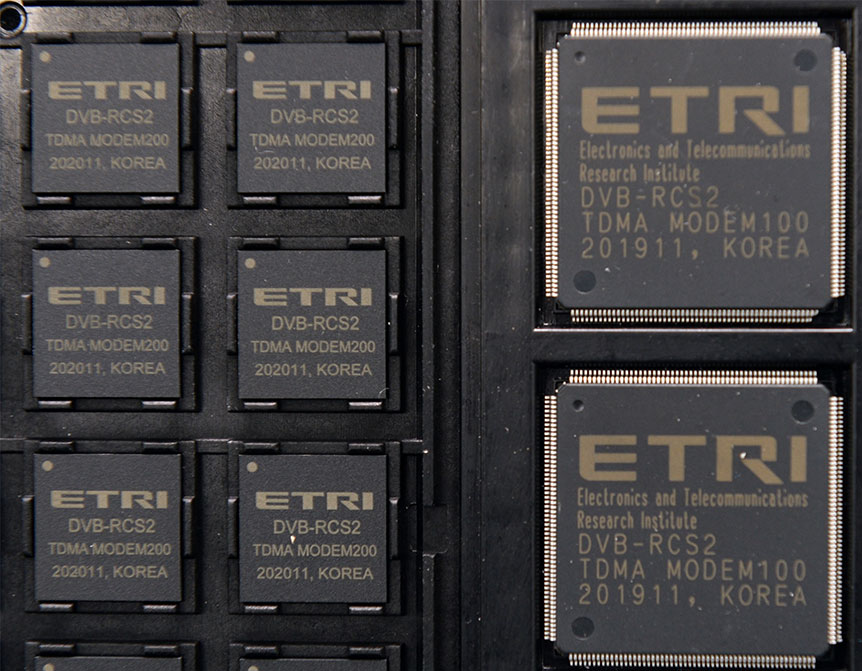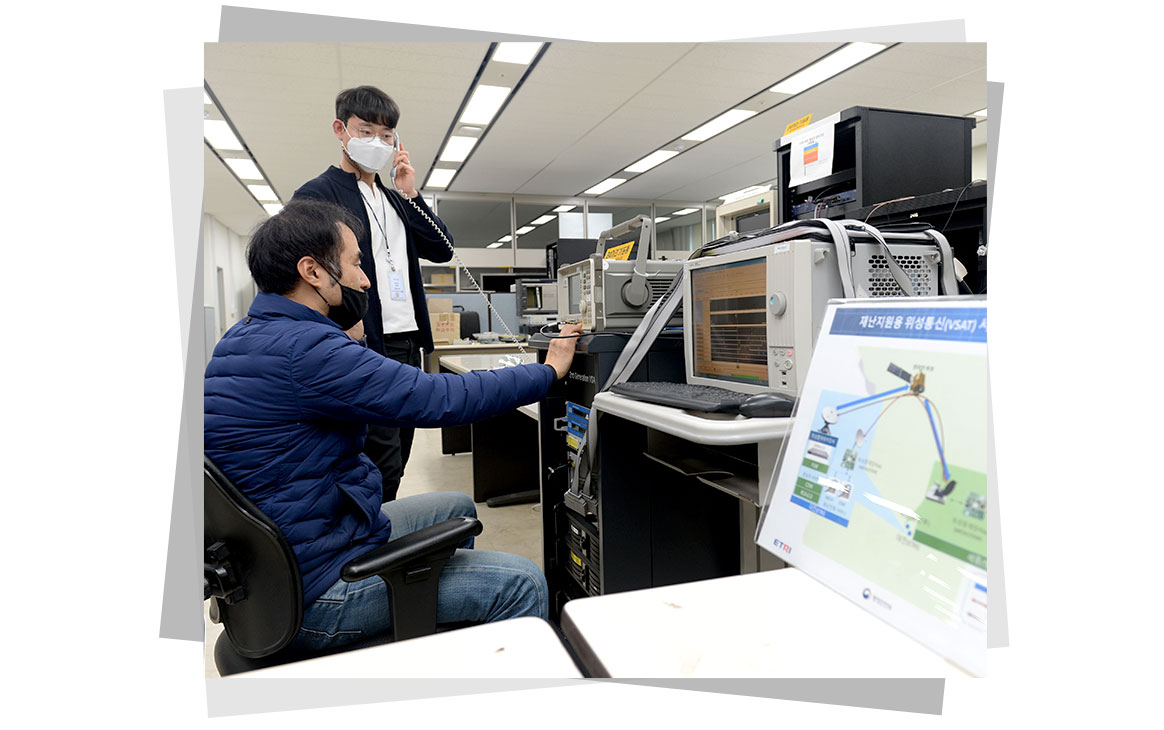VOL. 63 February 2021
ETRI, emergency response to disaster through satellite communication.
- Localization of mesh topology-based satellite communication chip (ASIC), on-site emergency response
- Miniaturization, 32 channels, transmission speed of 13Mbps, spread spectrum level of 16
- Communication available even in disasters and shaded areas in mobile communication

Researchers in Korea have developed a technology that facilitates rapid satellite communication even during man-made or natural disasters, or in places with no access to cellular networks. This technology will make the chips of core components for satellite communication smaller, much cheaper, and applicable at disaster sites or for military communication networks.
The Electronics and Telecommunications Research Institute (ETRI) announced on the 9th that it had succeeded in developing a world-class mesh topology-based1) satellite communication modem chip application-specific semiconductor2).
This technology enables communication where existing mobile communication is not available in the event of natural disasters such as fire or earthquake, or communication-related accidents such as fire at a telephone company.
Compared to mobile communication enabled by ground base stations, satellite communication is available even on islands and in mountainous areas without being limited by geographical constraints, and in the event of man-made and natural disasters.
1) One of the physical network connection methods. Each node is directly connected to the network. Data can be directly exchanged between terminals.
2) ASIC: Application-Specific Integrated Circuit, a customized semiconductor for a specific application required by users.

Satellite communication has basically used Star Topology3) technology, through which direct communication between terminals is not possible but must go through a repeater called a “hub.” It has a disadvantage of longer connection path4) and delay time due to such structure.
In contrast, the mesh topology method has the advantage of shorter delay time5) due to its structure but requires additional receiving equipment. Accordingly, ETRI has developed the modem chip (ASIC)6), which combines the signal transmitting and the receiving part into one while adopting the mesh method.
The newly developed modem chip measures 1.3 cm x 1.3 cm, as big as a 50-won coin. The chip is more compact than general-purpose chips for various uses, carrying only the functions required for satellite communication.
While the existing star topology-based communication has a delay time of 0.5 seconds, the mesh modem chip has halved the signal propagation delay time to 0.25 seconds. If the chip is commercialized, the materials cost of a communication terminal, which already reaches about several million won, is expected to be reduced.
Furthermore, the number of channels simultaneously transmitting signals has increased up to 32 with maximum transmission speed of 13 Mbps7), enabling smooth video streaming and supporting spread spectrum transmission level8) of up to 16.
3) One of the physical network connection methods. It has a hub in the center and the shape of a star or a wheel, and it is most widely used in Ethernet LAN
4) Transmitting terminal → Satellite → Central hub → Satellite → Receiving terminal (2-hop)
5) Transmitting terminal → Satellite → Receiving terminal (1 hop)
6) ASIC: Application-Specific Integrated Circuit
7) Mega Sample per second. The number of digital data outputs per second is 0.128~4.096Msps, similar to 13Mbps at the maximum
8) Broadband communication method using Spread-Spectrum Technology. The higher the number, the better the performance using wider bandwidth

This ETRI-developed technology is as valuable as of the world's best products that are currently commercially available.
It also meets DVB9)-RCS2, the latest standard for open international satellite communication. The satellite communication verification test through the Cheollian satellite has proven its potentially diverse applications.
In the future, the research team plans to verify the technology to offer communication services for real-time on-site control at actual accident and disaster sites through demonstrations with the Ministry of Interior and Safety, Korea Coast Guard, and National Emergency Management Agency.
“The commercialization of satellite communication will make stable use of the disaster safety communication network, narrow the information gap between cities and remote mountain and island areas, and enable military communication in military operations, thereby contributing to increasing the public's convenience and improving the quality of life,”said BYUN, Woo Jin, head of the Radio & Satellite Research Division at ETRI.
In addition, ETRI plans to transfer this technology to domestic companies, thereby contributing to the improvement of domestic satellite ICT and strengthening competitiveness and allowing domestic companies enter the satellite ICT market, which is dominated by foreign technologies. Today, the global satellite communications market is led by the US and Israel 10) with a combined share of 68%.
The findings of the research team were studied by the Ministry of Interior and Safety's『Development of small-sized, Satellite News Gathering (SNG) vehicle for Disaster Site Support』.
9)Digital Video Broadcasting. The European open standard for digital television. Korean satellite broadcasting also adopts this standard
10)US Hughes, Israel Gilat

